Nothing makes me happier than hearing an old dog is going to a new home, so congratulations!! How great you must be feeling, knowing you are giving a homeless animal a kind and loving home in the last months or years of life.
In the first few days it’s best to keep things as calm in the house as you can. No welcome home parties, no visitors wanting to catch a glimpse of the new family member. Set up a quiet area just for him and limit access to the entire house until he becomes more comfortable. Take him for frequent walks to prevent accidents, always on a leash, and get him started on his routine right away.
How to Prepare Your Home For a Senior Dog
Buy supplies
Picking up your new dog and taking him shopping for supplies, isn’t the best way to kick things off. Your dog may already be stressed, walking him through a crowded big box store won’t help.
Use this article as a reference for what you’ll need – “How to Choose the Right Supplies for Your Senior Dog”
Set up his space
Have beds and filled water bowls in place. I use plural because with old dogs especially, I like to give them easy access to the important stuff. They shouldn’t have to walk far to get a drink or have a rest, and if he has mobility issues it’s even more important.
An Adaptil plug in is calming for many dogs, so put one in the room he will spend the most time in.
Where will he sleep?
Do you mind if he sleeps in your room? What about in your bed? Would you rather he’s in another room? Decide in advance where his spot will be, and start him off there his first night. Don’t be surprised if he starts off in the kitchen and ends up hogging your whole bed!!
Establish a schedule and routine
In my experience dogs find comfort and are more relaxed when they know roughly when they’ll be eating and going out. I find dogs with no routine tend to me on alert, never knowing what’s happening when. I’m not suggesting things have to happen exactly the same time every day, but I also don’t recommend one morning they eat breakfast at 7:00, the next at 9:30. My dog schedule can vary by about 20 minutes or so, unless we’re out for the day and then there’s no schedule!
Until your dog gets used to being in a new home, I would add some potty breaks in between scheduled walks to reduce accidents. Try it for a week and see how things go.
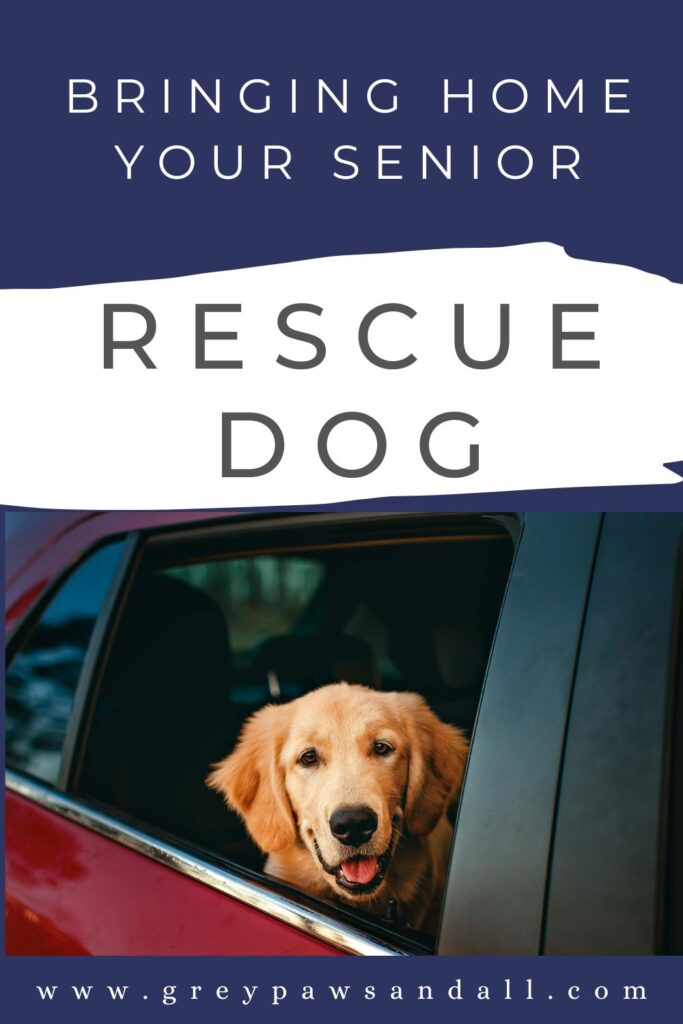
House training a new senior dog
He may already be house trained, but forgot due to months or years in a shelter. Two or three weeks on his new schedule may be all he needs to remember. If he’s never been house trained, it’s not too late to start.
Here are a few tips to get you started:
♦ The fewer opportunities to have an accident in the house, and the more opportunities he has to go outside, the faster house training is going to be.
♦ The following advice is what’s often recommended for puppy training, but it’s a good place to start with your old dog as well. As you get to know him, adapt the following schedule to his (and your) needs.
♦ Take him out every hour or hour and a half in between scheduled walks for a quick pee break.
- Keep him on a leash
- Make the outing boring so he doesn’t think it’s play time
- Wait 5 or 10 minutes then bring him in
♦ It’s okay if nothing happens, it’s about getting him used to going out regularly and preventing accidents.
♦ For the first few days until you see how he is, having him on a leash attached to your belt or belt loop will prevent accidents. When you can’t have him with you or you need a break, use a puppy play pen or block off an area using a baby gate. Leave water and a toy, but you still must take him out regularly.
♦ Take him out as soon as he wakes up, and if you’ve been out for a couple of hours then as soon as you get home.
♦ Don’t punish your dog for having an accident in the house. Think about whether you or others in your home have been vigilant enough, or some pee breaks are being missed.
Helpful tip: After he’s peed or poop reward him immediately with praise “good boy” or “good girl” in an excited voice and a treat.
NOTE: There is a section further down in this article about vet visits, but it’s worth mentioning here. If you notice your dog drinking and peeing a lot, be sure to schedule a vet visit. Another option is to bring a urine sample to the vet for analysis, and then see if your dog needs an appointment.
Discuss responsibilities
If there are others living in the house with you, gather everyone together to discuss who’s going to do what. Can someone take care of early morning walks? Who will feed him dinner? Please ensure everyone understands the importance of taking their responsibilities seriously, and if they aren’t able to step up for one of their shifts, they need to find someone who can.
Make a chart and post it where everyone can see it, and have everyone schedule it into their phone.
Senior dog proof your home
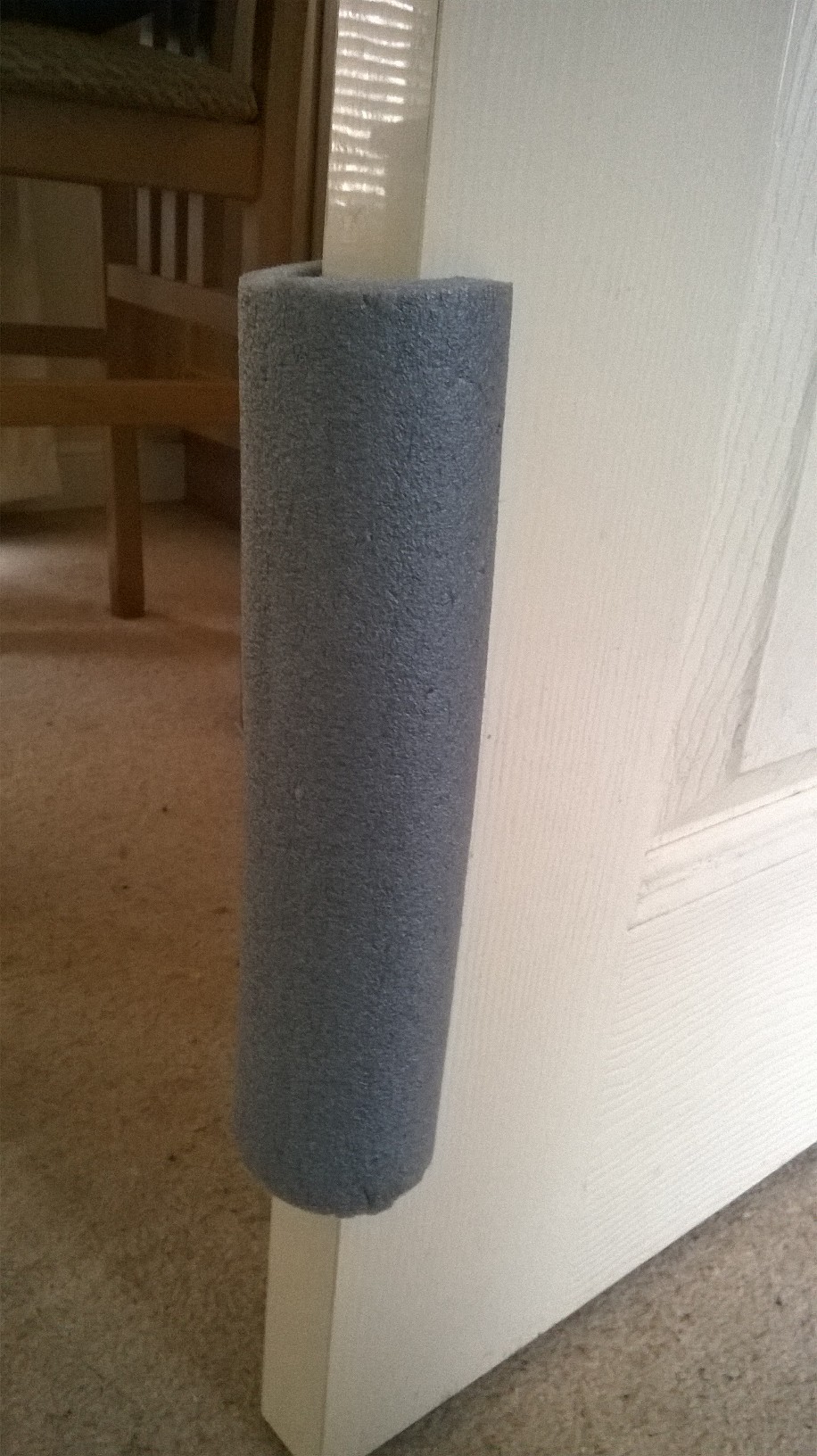
These tips are helpful in general, but particularly important if your dog is blind or has mobility issues.
- Keep the basement door closed or use a baby gate
- Don’t leave toys or other items on the floor your dog could trip over
- Cover sharp edges of your coffee table
- If the water bowl is near a pointy drawer handle, wrap the ends in fabric (yes it does help!)
- Chair legs, table legs and door edges can be covered with pipe insulation, slit lengthwise (picture above)
- Tuck cables away so legs can’t get tangled in them
- Don’t rearrange furniture if your dog is blind
- Get down on the floor at your dog’s eye level and see what else could be an issue
- Put a baby gate at the bottom and top of the staircase
Check your outside space
- If your backyard is fenced in check for holes, loose fencing, dodgy gate locks or piles of stuff he can climb on and escape
- Get rid of any clutter he could hurt himself on
- Check for holes in the grass he could step into
- If there are steps leading out to your garden or front door, a ramp will help
- Don’t leave your dog alone outside if your pool is not fenced in. Swimming is a great form of exercise for all dogs, but only when supervised
What will you feed your senior dog
If you’re planning on changing his food, you need to make the transition gradually so he doesn’t get stomach upset. Feed him what he’s been eating in the shelter or foster home, then each meal add a small amount of the new food until he’s completed switched over in about a week. A senior dog’s stomach is often more sensitive then their younger counterparts, so if you notice a bit of diarrhea, you may be switching over too quickly.
It would be helpful knowing if any medical issues are present, as certain foods could be off limits, at least temporarily.
Dog nutrition is a confusing issue, with experts convinced their beliefs about your dog’s nutritional needs are right. The problem is they all believe different things, so who’s right? While I can’t tell you what to feed your dog, I can share some tips that will help get you started.
Dog food comes in:
- Dry kibble
- Wet food
- Freeze dried
- Dehydrated
- Raw
- Make your own
- Fresh food delivered to your door
Making your own may sound like a lot of work, and although it takes some time to prepare, you can batch cook and freeze.
Some brands have a broader range of types and flavors than others.
Many claim to have added supplements like joint support for example. Since it’s hard to determine how much is actually in the food and the amount your dog will be ingesting, it’s better to buy your own supplements.
Quality varies widely, so label reading is important. Some brands contain little or no meat or vegetables and a load of additives no one understands, while others are pure protein, fruits and vegetables.
I’m generalizing when I say this but…many vets don’t know that much about nutrition. You should still get recommendations, but question ingredients and the benefits of that/those particular brand(s). Another helpful resource is a holistic vet or canine nutritionist.
Choose the best time to bring your new dog home
Rather than bringing him home after work on a Monday evening when you have to be at work Tuesday morning, how about Friday so you have the weekend to help him acclimate? Better yet, you may have a few days off coming up.
What To Do When You First Bring Your Senior Dog Home
Take a walk
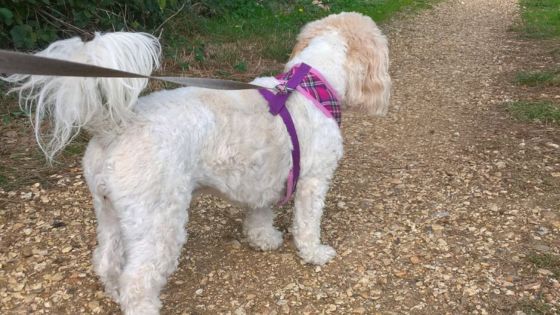
Before you go inside, walk your dog around the outside of your house or apartment building. Give him time to take in the new smells and sights. A walk will burn off some nervous energy, and give him a chance to pee and poop.
Introducing a new dog to an existing dog
The dogs have probably already met, but not in Frank’s house. That’s what we’re going to call your resident dog so it’s easier to follow.
You want this meeting to go well, so introduce them in stages.
Have them meet first on neutral ground – perhaps a road you haven’t walked down before and walk them together.
Next, if you have a fenced in yard you can have Frank outside, and let them sniff/see each other through the fence.
Inside your home
For the first day or so, keep your new dog in a separate area of the house. If you don’t have the space, a spare bedroom or area you can block off with a baby gate will work too. Be sure to have a bed, water bowl and some toys already set up, and he’ll eat his meals in there too!
Keep Frank outside while you give your rescue dog a tour of his new home. Walk him around on a leash, show him the various rooms and where his beds and water bowls are.
Put him in his area, then bring Frank in.
NOTE: Your dogs may get on great from the beginning, so keeping one in a separate room may not be necessary. At the very least, don’t leave them alone together when you first come home and keep your senior dog on a leash for the first meeting.
Introducing him to kids
It’s never a good idea to leave children alone with dogs, especially one you’ve just adopted, so all interactions must be supervised. Your old dog has lived a lot of years, backgrounds aren’t often known, and you’ll need time to figure out how well he responds to children.
Even if he’s the sweetest thing ever and came from a foster home with kids he loved, stress and anxiety from being in a new environment can cause him to lash out.
Limit visitors
I imagine there are a lot of people who can’t wait to meet your new family member, but they’ll have to settle for a picture for the time being. Your dog needs a few days, or longer, depending on how easily he acclimates.
When you do have company, invite one person at a time and don’t force interaction. Let the dog decide if he wants to meet them or not.
NOTE: Your dog may be easy going and be happy to meet some new folks. You’ll be the best judge.
Settling a Rescue Dog at Night
Your old dog has been through a lot his first day. I know you’re excited and want to get him settled in, but there’s a fine line between getting him comfortable and smothering him. Give him space to be on his own, or he could be on his way to developing separation anxiety.
As I mentioned earlier, start your dog sleeping where you want. If you let him in your bed the first night because he’s having a hard time coping, it will be hard to get him off (unless you don’t mind).
Here are some tips to help:
- Exercise your dog before bed. He will have a chance to pee, and a tired dog will sleep better
- Use an Adaptil plug in near where he’ll be sleeping. The pheromones should help relax him
- If the shelter or rescue gave you a blanket he slept with, put that on his bed
- Dog calming music is very relaxing, and there is a huge selection on Youtube
- Put pee pads around the area in case he has to pee in the middle of the night
- If he starts whining or barking, be careful about running to him every time, because he’ll quickly learn it gets him what he wants. Having said that, you can’t ignore it if he’s in pain or needs to pee and/or poop. If there’s no reason to think it’s pain and he’s just been out, it’s probably the stress of being in an unfamiliar environment. Ignore him for a few minutes and see if he stops.
Over the Coming Days, Weeks or Longer
See your vet
Give your dog time to settle in, but if he seems to be doing well in a week or so, schedule an appointment with your vet. If you were given any medical records, forward them in advance of your appointment.
Old dogs should be seen by the vet twice a year, and ideally blood and urine tests done as well. It’s the best way to monitor your dog’s health.
In the early days, you won’t be familiar with what’s normal and not normal behavior for your dog. As you get to know him better, if you see anything out of the ordinary, even if it’s something you can’t quite put your finger on, it’s important to have him seen by a vet. Catching a problem early means there’s a better chance of treating, or at least managing the condition.
Carry on with training
Training will teach your old dog how to live in your home, keep him safe and provide a great opportunity to bond with each other.
Physical exercise and mental stimulation
Every dog needs to keep their body moving and mind active. The type, frequency and intensity of that physical exercise will depend on the health and wellbeing of your dog.
Keep walks short and at a slower pace at the beginning, until you see how well he handles them. Old doesn’t mean lame, and plenty of older dogs can give a puppy a run for his money, but it’s still best to start off slow.
If your dog has mobility issues, a wagon or stroller would be a great investment. Your dog can walk as much as he’s able, and when he needs a rest he can go for a ride. He’ll enjoy the fresh air and great outdoors, and it will be easier for him to be included in family outings.
During the long cold days of winter, it can be challenging providing enough exercise. Here are ideas for exercising your dog indoors. Read this ⇒ “18 Ways to Exercise a Dog Indoors“
Socialization
Slowly start introducing him to new sights, sounds, and visitors, but if your dog is very nervous start off closer to home. How about something simple like sitting together on the front porch. Give him a few treats when he seems calm to create positive associations, meaning good things happen when he’s outside.
How Long Does it Take an Older Dog to Adjust to a New Home?
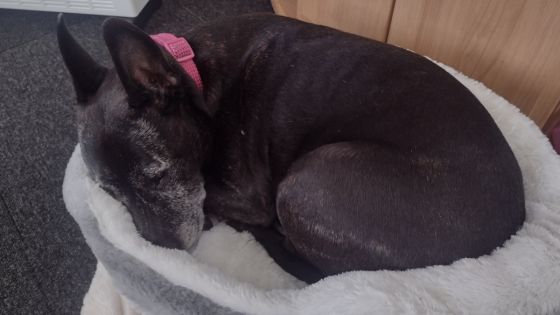
Some dogs settle in very quickly while others can take days, weeks or even months. A lot has to do with their background and experiences. I’ve adopted old dogs that settled in right away, and a puppy mill rescue named Saffy who didn’t let me pet her for 7 months.
The most important thing is not to put a time limit of how long you think it should take. Be patient and things will fall into place.
The picture above is of my 11 year old foster dog Roxy. This was taken the first day she arrived, and you can tell she had no trouble making herself right at home!
Avoid These 7 “New Senior Dog Owner” Mistakes
Not socializing the dog
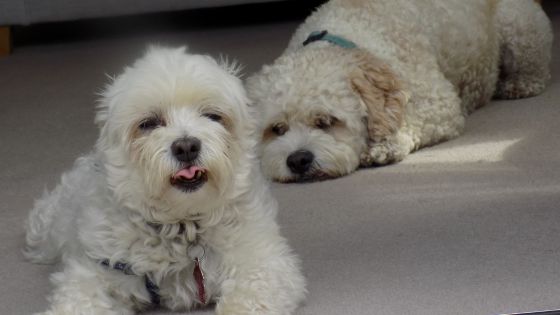
We all know how important it is to socialize a puppy, so why shouldn’t it be just as important to do the same for an older dog! Slowly getting him used to people, places and things will help him live a calmer and more peaceful life. Imagine the anxiety when every day there’s something new and unfamiliar for him to cope with.
Lack of consistency
Before you brought your old dog home, you sat together as a family and talked about the rules and division of responsibility. He’s only been home a few days and you’re already seeing a lack of consistency.
If your dog is not allowed to beg for food at the table but one of your kids is slipping him some, how can your dog learn begging is not acceptable? He’s already seen that isn’t the case.
Not following the rules/schedule
Believe it or not, it is anxiety causing for a dog when they have no idea what’s happening when. I’m not referring to the family outings you take, or the extra hike in the woods, but the basics such as meal and walk times.
For example, one day your dog eats at 7:00, the next at 8:30 and the next at 10:15, then it’s at 6:20. He doesn’t have to eat exactly the same time every morning, but it should be within about 30 minutes or so.
This can be particularly important for an old dog who isn’t eating as well as he should, or medication schedules that need to be followed.
Not seeing the vet enough
Many changes witnessed by senior dog owners are attributed to a natural part of getting older. For example, it is assumed vision loss is part of aging so nothing is done about it. Not every old dog will go blind, and in some cases eye sight can be saved.
Some senior dog parents expect an older dog to spend most of the day in bed, when in fact they’re in pain from arthritis. They don’t realise a lot can be done to get them out of pain and enjoying walks ⇒ “5 Effective Ways to Reduce Pain in Dogs With Arthritis”
See the vet twice a year, and if you notice any changes no matter how slight. A problem caught early has a much better chance of being treated, or at least managed.
Lack of exercise and mental stimulation
Old dogs need exercise just like young ones, the difference may be the type and frequency. Is he up for a hike or are 4 or 5 short walks a day better? How about swimming? A home made obstacle course? Play dates with other doggy friends of similar activity level?
Mental stimulation can not only help prevent/delay dementia, it also helps burn off excess energy, particularly important for dogs with reduced mobility.
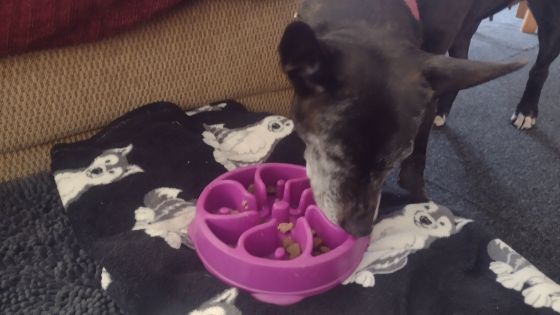
- Puzzle toys
- Play hide and seek with your dog
- Stuff a snuffle mat with treats or a meal
- Use a slow feeder as in the picture above
- Instead of using a bowl, scatter some of your dog’s food on the floor and let him find it. Probably best done with dry food.
- Fill a Kong with food he has to find a way to get out. Freezing it slightly makes it more challenging
Having unrealistic expectations
It’s possible your new old dog will come bounding in, jump on the couch, and settle in like he’s lived there all his life…but don’t be disappointed if that doesn’t happen.
Your dog has just been uprooted from where he was living, and brought into what he likely sees as a strange and scary environment. He’s spending most of his time hiding under the bed or in a closet, and has already peed on your carpet.
Having volunteered in shelters, I’ve seen first hand how unrealistic expectations lead to these poor dogs being dumped pretty quickly.
Give him time to adapt.
Allowing an existing dog to bother the new arrival
Your resident dog may be all excited to have a playmate, but don’t let him jump all over your new dog. Have them greet each other on a leash and supervise them when they’re together. You’ll need to teach your dog to play gently with the newcomer, and when he gets too boisterous, re-direct him with a fun play session, a bone or Kong to chew on instead of the dog!
If you’re looking for a community of senior dog parents, a place where you can find helpful tips, support and people who “get it” please join my FB group Senior Dog Care Club
I help senior dog parents struggling with anticipatory grief and quality of life issues by offering practical tips, advice and one on one support.
I am also a Certified Pet Loss Specialist, helping you navigate through your pet loss journey.
Click this link to book a FREE 20 minute discovery call, visit my service page (senior dog care or pet loss) to find out more or email hindy@greypawsandall.com if you have any questions.
I’ve been rescuing and caring for senior dogs since 2009. From vision and hearing loss to obesity, dementia, kidney disease, liver issues, cardiac problems, Cushing’s, mobility challenges and more, you could say I’ve dealt with and learned a lot! In addition to my hands on experience, I’ve taken many courses and earned several qualifications to keep learning how to help senior dogs and they include: Senior Dog Enrichment, Understanding Canine Anxiety, Care of the Senior Pet and I’m a Certified Pet Loss Specialist.

